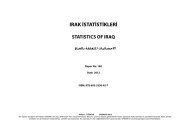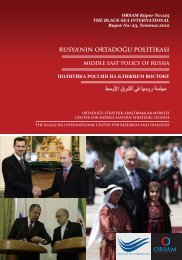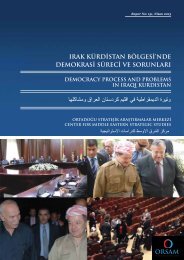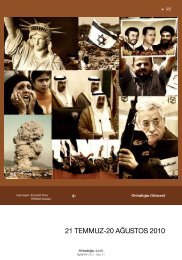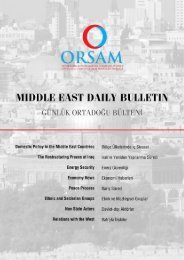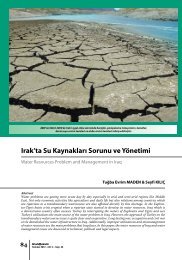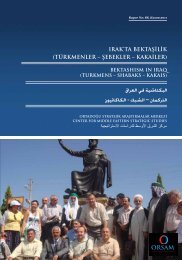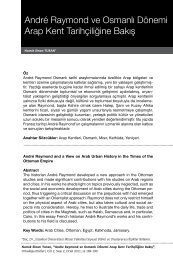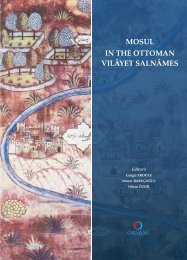turkmen in iraq and their flight - orsam
turkmen in iraq and their flight - orsam
turkmen in iraq and their flight - orsam
Create successful ePaper yourself
Turn your PDF publications into a flip-book with our unique Google optimized e-Paper software.
ORSAM Report No: 87<br />
CENTER FOR THE MIDDLE EASTERN<br />
TURKMEN STUDIES<br />
Report No: 16, November 2011<br />
By Dr. İbrahim Sirkeci<br />
Reader <strong>in</strong> Demography <strong>and</strong> Market<strong>in</strong>g<br />
Regent's College, London, UK<br />
ORSAM-ORTADOĞU TÜRKMENLERİ<br />
ARAŞTIRMALARI MERKEZİ<br />
ORSAM<br />
ORTADOĞU STRATEJİK ARAŞTIRMALAR MERKEZİ<br />
TURKMEN IN IRAQ AND THEIR FLIGHT:<br />
A DEMOGRAPHIC QUESTION<br />
Executive Summary<br />
Ethnic <strong>and</strong> religious conflicts, power struggles <strong>and</strong> wars have determ<strong>in</strong>ed <strong>and</strong> shaped the fate of contemporary<br />
Iraq throughout the second half of the last century <strong>and</strong> <strong>in</strong>to the new millennium. These<br />
conflicts have largely prevented the collection of data <strong>and</strong> therefore healthy analysis of the country’s<br />
demography for a long while. The demographic eng<strong>in</strong>eer<strong>in</strong>g took place dur<strong>in</strong>g the Baath regime <strong>and</strong><br />
perhaps still <strong>in</strong> progress <strong>in</strong> the country is one key reason why the <strong>in</strong>ternational community as well as<br />
Iraqis themselves do not know for sure what the country is made of, ethnically <strong>and</strong> religiously. Therefore<br />
all studies <strong>and</strong> reports on Iraq are based on partial data which can be controversial as there is<br />
practically no reliable population frame from which anybody can draw representative samples or test<br />
the representativeness. The two surveys form<strong>in</strong>g the basis of this book/report are also not free from<br />
that potential fallacy. However, given the paucity of data <strong>and</strong> analysis from war torn Iraq, every little<br />
research helps a great deal to underst<strong>and</strong> population dynamics <strong>in</strong> the country <strong>and</strong> possibly <strong>in</strong>form the<br />
national <strong>and</strong> <strong>in</strong>ternational policy choices.<br />
The two <strong>in</strong>ternational migration surveys were conducted <strong>in</strong> Iraq <strong>and</strong> Turkey respectively. The one conducted<br />
<strong>in</strong> Iraq targeted Iraqi Turkmen households <strong>in</strong> major cities <strong>and</strong> towns <strong>in</strong> the North <strong>and</strong> Bagdad.<br />
The chosen areas where sizeable Turkmen populations exist were surveyed by a r<strong>and</strong>om sampl<strong>in</strong>g<br />
method employed <strong>in</strong> the field. Although 1500 households were aimed to reach, our field teams were<br />
only able to complete questionnaires <strong>in</strong> a total of 1040 households. About one third of the households<br />
were identified as migrant households where at least a member of the household is a migrant or was<br />
once a migrant. This is a far higher figure than <strong>in</strong> many traditional migrant send<strong>in</strong>g countries.<br />
The second survey was carried out almost simultaneously <strong>in</strong> major cities <strong>in</strong> Turkey, aga<strong>in</strong> by consider<strong>in</strong>g<br />
where large Turkmen immigrant communities exist. A total of 161 questionnaires were completed<br />
most of whom were r<strong>and</strong>omly selected from Iraqi Turkmen Front registers while convenience sampl<strong>in</strong>g<br />
was used to reach respondents <strong>in</strong> Istanbul.<br />
In l<strong>in</strong>e with my conflict model of migration, Iraqi Turkmen migration is follow<strong>in</strong>g a pattern that corresponds<br />
to lows <strong>and</strong> peaks of various conflicts <strong>and</strong> degree of <strong>in</strong>tensity of conflict <strong>in</strong> Iraq over the time.<br />
Turkmen’s perception of relative security <strong>in</strong> Turkey <strong>and</strong> other dest<strong>in</strong>ation countries <strong>in</strong> comparison to<br />
relative <strong>in</strong>security <strong>in</strong> Iraq is the key driver <strong>in</strong> <strong>their</strong> <strong>in</strong>ternational migration experiences. Apparently<br />
background variables such as age, gender, <strong>in</strong>come, education <strong>and</strong> employment are all play<strong>in</strong>g <strong>their</strong><br />
part <strong>in</strong> the decision mak<strong>in</strong>g. Nevertheless, the wars Iraqis have faced <strong>and</strong> suffered from dur<strong>in</strong>g the last<br />
two or three decades drew the l<strong>in</strong>e between mov<strong>in</strong>g <strong>and</strong> not mov<strong>in</strong>g as well as decid<strong>in</strong>g when to move.<br />
The largest portion of outmigration took place after 1990.<br />
9




